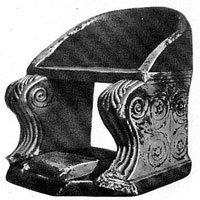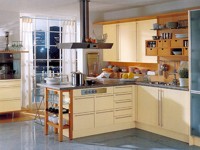The Psychology of Smooth Lines in Design
 “The tyranny of the line has become absolute. A straight line is something cowardly, drawn along the line, without emotions and thoughts; it is a line that does not exist in nature … Any design based on a straight line will be stillborn ”- Hundertwasser.
“The tyranny of the line has become absolute. A straight line is something cowardly, drawn along the line, without emotions and thoughts; it is a line that does not exist in nature … Any design based on a straight line will be stillborn ”- Hundertwasser.
The psychology of smooth lines in design. The shapes, lines, sizes of objects and objects around us play a much larger role in our life than we think. Many people believe that the rounded shape of the furniture, the bends of the facades, the multi-level surfaces of the ceilings are just a way to decorate objects, and you can completely do without all this decoration. But it is not so.
Simple rectangular shapes of rooms, furniture with sharp corners, as a rule, are more functional. They have a large usable area, and are cheaper. In nature, rectangles are found only at the macro level. But this level is not available to our eyesight. We admire the result: a variety of forms of animate and inanimate nature. We are surrounded by many objects of the correct form – rectangular, round – only because they are easier to manufacture, pack and deliver.
In addition, scientists have long proved that smooth, rounded, curving lines positively affect the human psyche, and achieve internal harmony. And chopped, even, rectangular shapes can make a person more closed and agitated. In addition, in our days, designers so often use rounded corners that they can already be considered an industrial standard, and not a fashion trend. They are found not only in programs, but even in the design of hardware devices. What makes them so popular? Lines change visual perception. With their help, you can visually expand or reduce the room, mask irregular shapes.
Even in the smallest apartment you can find opportunities to place bends, curves and smooth lines. Curved lines pacify, lead to inner harmony. Subconsciously, they cause associations with natural motifs: the fluid flow of rivers, the softness of green hills. With their help, you can create a very poetic interior that will contribute to relaxation.
What is nicer to watch?
It is not necessary to use only one type of line. You can combine horizontal and vertical lines to simulate the space to your liking. Or locally add diagonals to highlight some part of the interior. Or by smoothly bending the ceiling cornice to soften the rigid geometry of the furniture.
Many architectural styles adopt smooth lines. First of all, I want to note my favorite baroque and modern. Art Nouveau is smooth, asymmetrical lines that easily flow into each other, repeating the elegance and naturalness of the forms. Nature has become one of the main sources of inspiration for designers creating art nouveau interiors. There is something bewitching in the development of plants: bud swelling, shoots, plexus of stems, geometry of the trunks, a complex crown pattern. Associative perception of forms and silhouettes is one of the signs of modernity. External space invades the inside of the house, and vice versa, the landscape is formed as a continuation of the interior.
Gaudi and flowing lines.
Antonio Gaudi – the most famous architect of Spain. Gaudi’s work marked the highest flowering of Spanish Art Nouveau. A distinctive feature of Gaudi’s style is that organic, natural forms (clouds, trees, rocks, animals) became sources of his architectural fantasies. Antonio Gaudi believed that the straight line is the product of man, and the circle is the product of God. Gaudi declares war on a straight line and forever moves into the world of curved surfaces to form his own, unmistakably recognizable style.
The outlines of the roofs and facades, the lines of windows and cornices of his houses float, flow, playfully heave, but just do not stand in the place where, it would seem, they should be – they look like frozen waves.
Rounded corners are also convenient containers for information, because they direct your eyes to the center of the rectangle. Thus, attention is concentrated on the contents inside the container. They also facilitate the perception of which line belongs to which rectangle. In contrast, sharp corners in the figures direct attention outside the container, so it’s harder for the gaze to concentrate inside. At the same time, it is more difficult to understand which line belongs to which container, if they are close to each other. The reason is that they are absolutely identical, whereas in a figure with rounded edges the line smoothly turns towards its container and everything becomes clear on an intuitive level.




